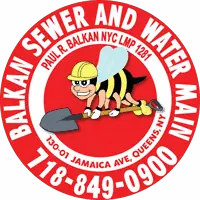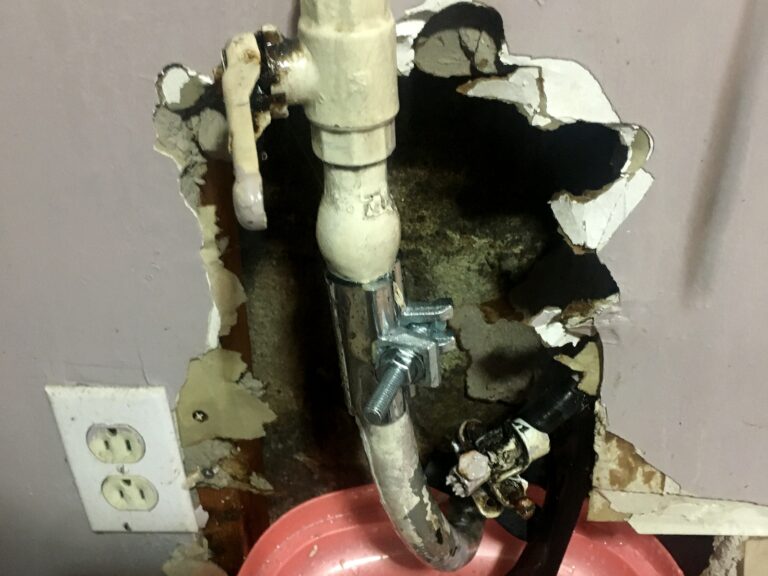New York City, besides being the largest city in the United States, is known for its towering skyscrapers and vibrant multicultural neighborhoods. Perhaps surprisingly, NYC is not immune to the geological phenomenon of sinkholes.
Over the years, these sudden and often catastrophic collapses of the ground have become a growing concern, and more visible to the general public. This article explores the causes, frequency, consequences, and cures of sinkholes in NYC.
This article will attempt to delve into whether sinkholes are more common now than in the past, and the various factors that contribute to the formation of sinkholes. Likewise, we’ll discuss the risks sinkholes pose to buildings, pedestrians, and vehicular traffic. In addition, we will shed light on how sinkholes can be repaired, and what measures New York City is taking to address the issue of sinkholes.
Courtesy of ABC7 News:
The 5 Major Questions and Answers About Sinkholes IN NYC
There are all sorts of questions that people have about sinkholes, why they form, and how they’re prevented and fixed. What follows is a 5-point question and answer of the 5 most common concerns that most people have.
I. The Growing Threat: Are Sinkholes in NYC More Common Now?
NYC sinkholes are getting an increasing amount of attention in recent years. This prompts 3 questions:
- Why do sinkholes happen in NYC?
- Are sinkholes becoming more common than in the past?
- Are sinkholes simply becoming more newsworthy in our social media society?
To answer these 3 questions, it’s helpful to attempt to understand the historical context, and current trends concerning sinkholes.
- Historical Perspective: Historically, NYC has not been a hotbed for sinkhole activity compared to other regions prone to them, such as Florida or Kentucky. In the borough of Manhattan, its bedrock foundation has played a significant role in limiting the occurrence of sinkholes.
- Recent Trends: However, there is evidence suggesting that sinkholes are becoming more frequent in NYC. Several factors contribute to this:
- a. Aging Infrastructure: The city’s infrastructure, including both public and private sewer and water pipes, is aging. As the city’s infrastructure ages and deteriorates, the likelihood of pipe collapses and leaks can trigger an increase in sinkholes.
- b. Increased Rainfall: Changing weather patterns, including more frequent and intense rainstorms, can lead to the erosion of soil and sediment around underground pipes. This can weaken the ground and make it susceptible to sinkhole formations.
- c. Lower Groundwater Tables: Changes in groundwater levels, often caused by over-extraction of groundwater, shifts in aquifers, or subsurface installations, can create voids in the earth that may eventually lead to sinkholes.
- d. Urban Development: The construction of heavy buildings, tunnels, and subway systems can alter the stress on underground rock formations, potentially contributing to sinkhole formation.
- Scientific and Government Research: The increase in sinkhole incidents in NYC has prompted scientists, geologists, and the government itself to conduct further research to better understand the underlying causes. They are monitoring geological conditions and potential warning signs more closely, which may help predict and prevent sinkholes in the future.
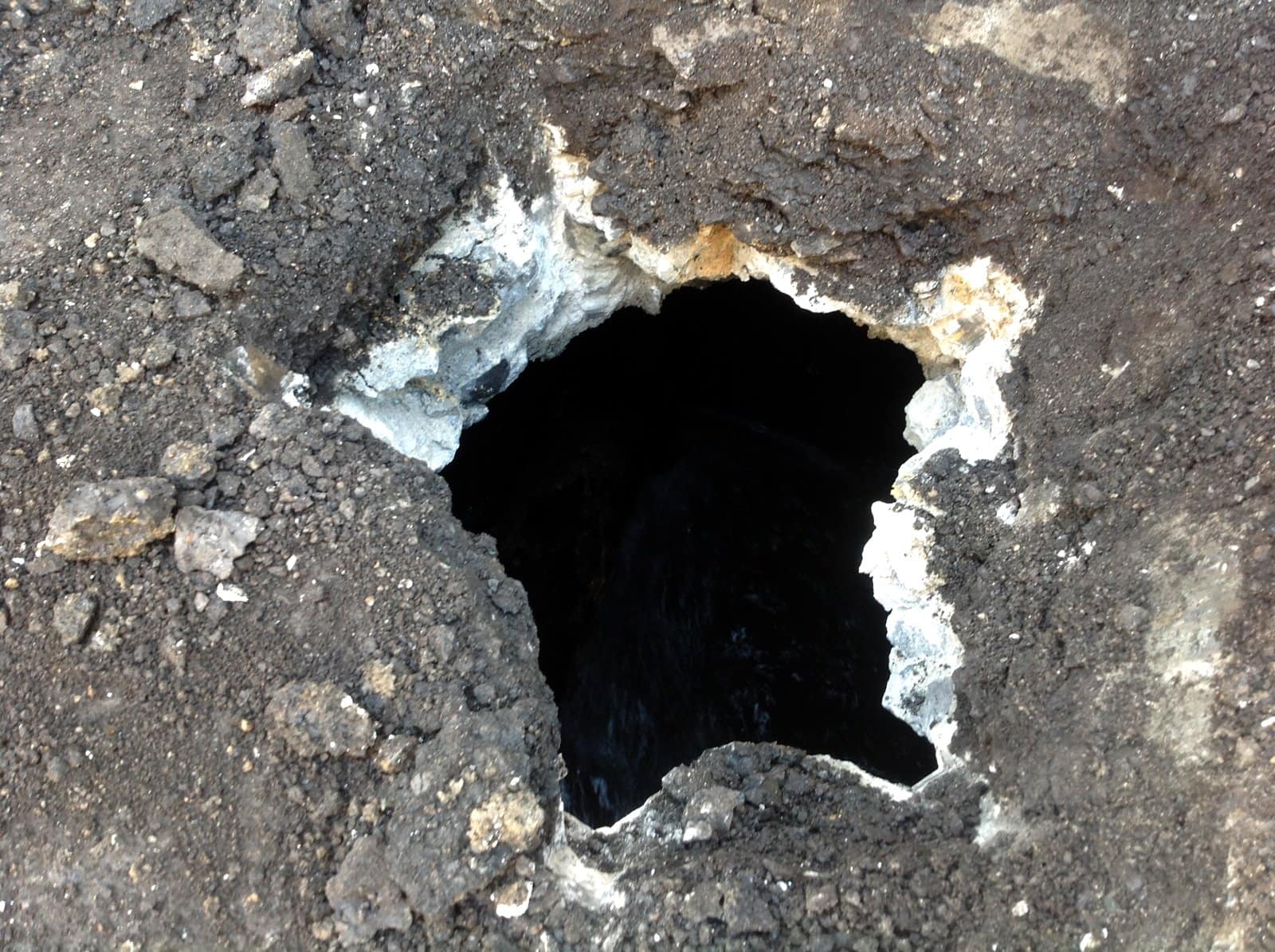
II. The 5 Major Causes of Sinkholes in NYC
Several factors can contribute to the formation of sinkholes in New York City. Understanding these causes is crucial to mitigating the risk and preventing further damage.
- Broken Sewer or Water Pipes: One of the most common causes of sinkholes in NYC is the deterioration and rupture of underground sewer and water pipes. Over some time, sewer and water pipes can become corroded. Of course, this leads to sewer and water line leaks and the erosion of the surrounding soil. Eventually, this can result in a void, causing a sinkhole to form.
- Heavy Rainstorms: Intense and prolonged rainstorms can lead to the saturation of the soil, especially in areas with poor drainage. This sudden and excess amount of water can infiltrate the ground, erode sediment, and weaken the underlying support. This will increase the risk of sinkhole formation. Sudden and extreme rainfall can and will cause sinkholes where none previously existed.
- Lower Groundwater Tables: Changes in groundwater levels can create voids in the earth, making the overlying surface prone to sudden collapses. This can be caused by excessive groundwater extraction, shifts in underground aquifers, subsurface installations of various sorts, or changes in precipitation patterns.
- Old and Broken Infrastructure: The aging infrastructure in NYC plays a significant role in sinkhole development. When a roadway is crumbling or porous, or decaying underground utilities, and failing support structures, all contribute to the formation of sinkholes. In an older city, such as New York City, even old and abandoned private septic systems can collapse over time.
- Urban Development: The construction and excavation associated with urban development can disturb the balance of forces within the earth’s subsurface. When there are major infrastructure projects, such as tunnels, subway systems, or deep foundations, it can lead to shifts in the underlying geological structures, creating conditions conducive to sinkholes. Likewise, the more green spaces that are cemented or paved over decreases the amount of rainwater being naturally absorbed.
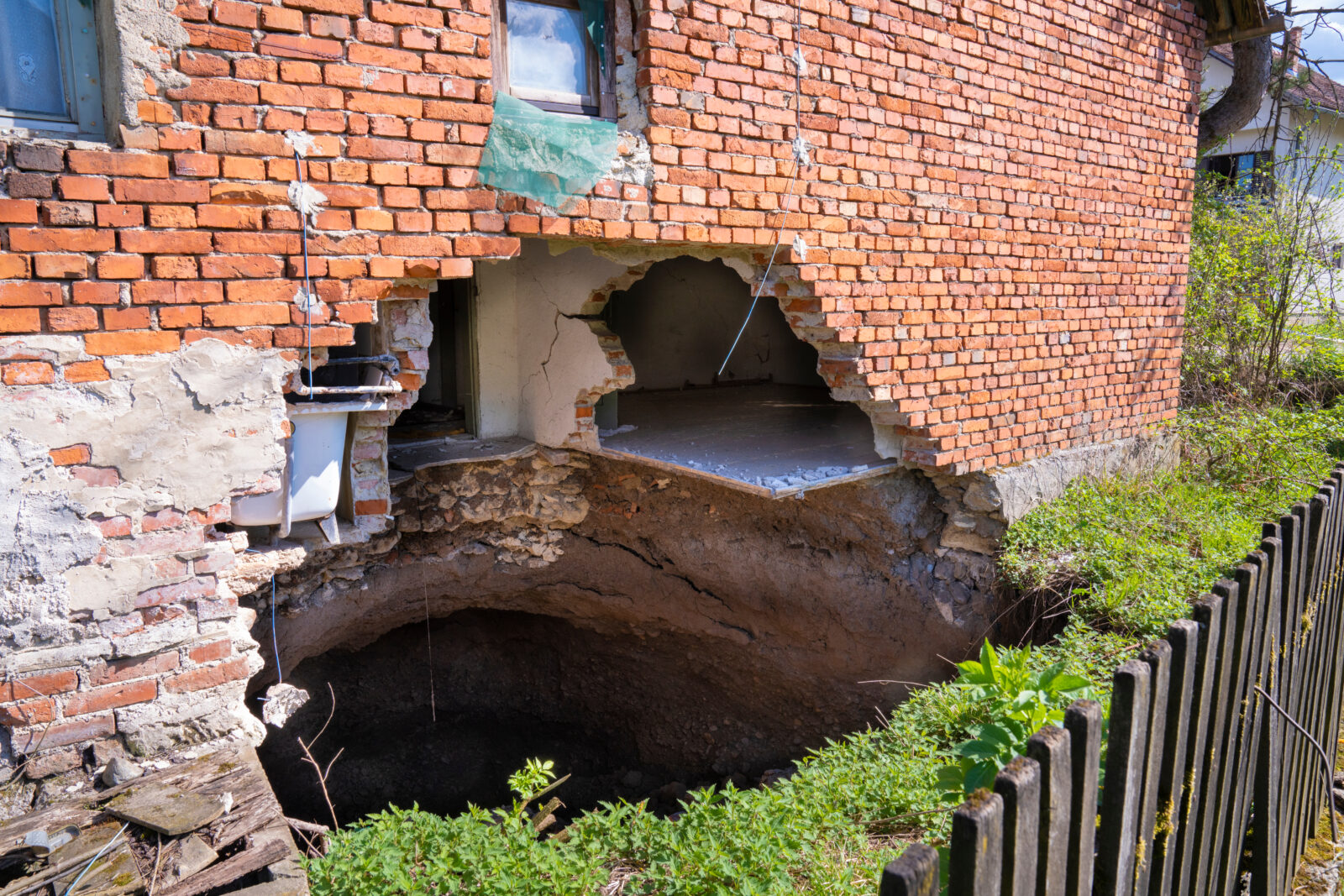
III. The 4 Major Dangers of Sinkholes
As most of us are aware, sinkholes can pose significant dangers to buildings, pedestrians, and vehicular traffic. Understanding the risks a sinkhole poses is crucial for public safety, urban planning, and the urgency of attending to the underlying issue.
- Building Damage: Sinkholes can cause severe structural damage to buildings and other infrastructure. Sudden ground collapses can lead to foundation cracks, wall damage, and even complete structural failure, potentially rendering buildings uninhabitable. In severe cases, a building might have to be deemed condemned and have to be demolished.
- Pedestrian and Bicyclist Hazards: Pedestrians walking or bicyclists riding near a sinkhole when it occurs are at risk of injury or death. Sinkholes can open up suddenly, leaving no time for evacuation or warning. Bear in mind that sinkholes occur at any time of day or night, even when there is virtually no line of sight.
- Vehicular Traffic Disruption: Sinkholes that appear on roadways can be extremely hazardous to vehicular traffic. Vehicles can fall into the sinkhole or collide with its edges, resulting in accidents, injuries, and traffic disruptions. In severe cases, a roadway may have to be fully closed until permanent repairs can be performed.
- Economic Consequences: The costs associated with sinkhole repair, property damage, and disruptions to businesses and transportation can be substantial, impacting the local economy.
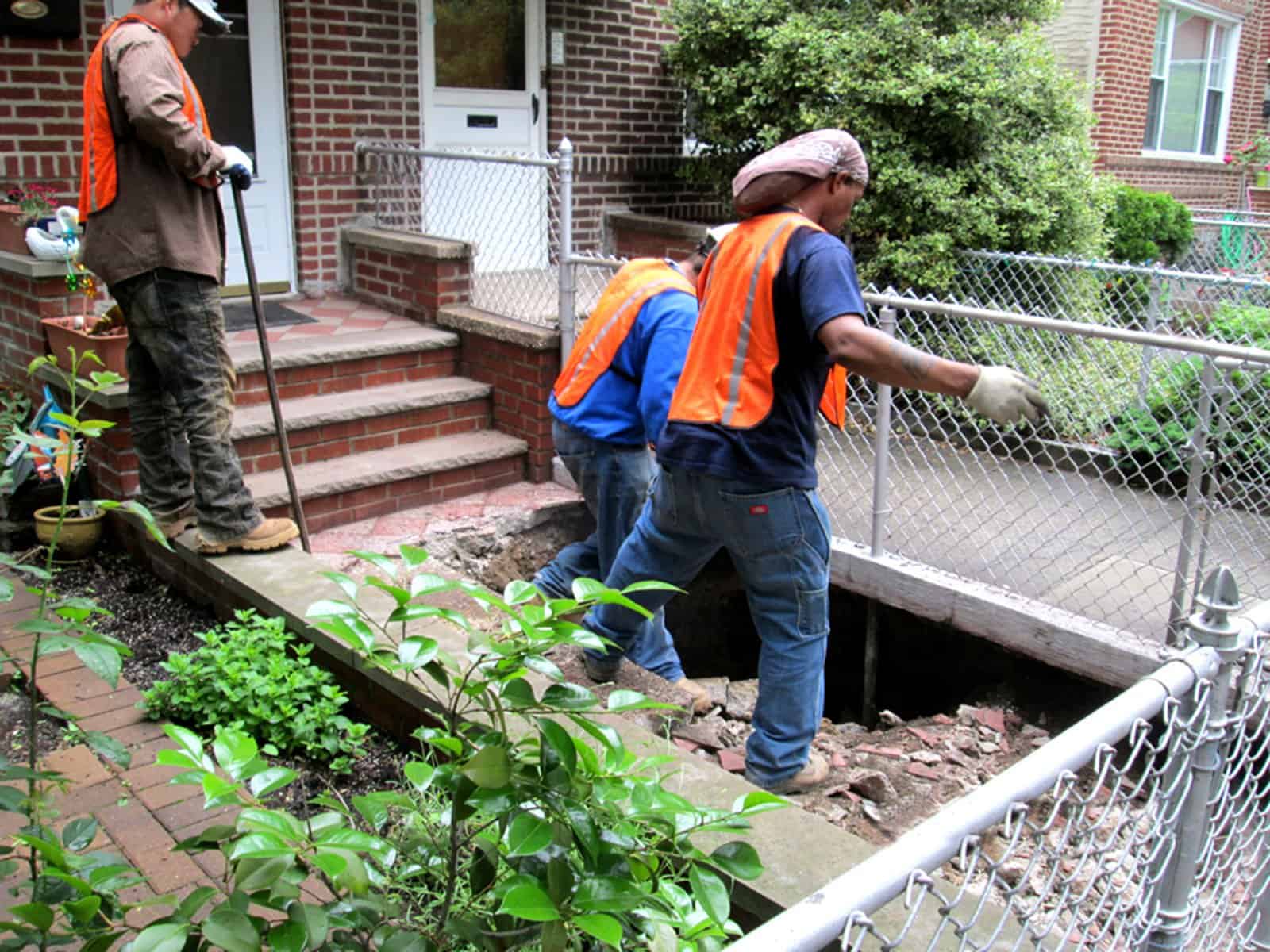
IV. Preventing and Repairing Sinkholes: A 6-Point Plan
When sinkholes in NYC do occur, it is imperative to respond quickly and effectively to mitigate both further damage and ensure the public’s safety. The repair of a sinkhole in New York City typically involves several key steps:
- Immediate Safety Measures: First and foremost, authorities must secure the area around the sinkhole to prevent further accidents or injuries. This may involve closing roads, evacuating nearby buildings, setting up barricades, and redirecting traffic (vehicular, pedestrian, and bicyclists as well).
- Assessing the Extent of the Sinkhole: Engineers and geologists typically assess the size and depth of the sinkhole to determine the underlying causes and select an appropriate repair strategy.
- Filling the Void Created: One common method of repair involves filling the sinkhole with suitable materials, such as sand, gravel, or concrete, to stabilize the ground surface. This process is carefully executed to ensure the void is completely and permanently filled.
- Infrastructure Repair (Roadway or Sidewalk): If the sinkhole is a result of a broken public or private sewer or water pipe, the damaged infrastructure must be repaired or replaced. This often requires excavation and replacement of the faulty pipes. If the fault is with a public pipe, the NYC DEP will address it directly. In some cases, the NYC DEP or NYC DOT may subcontract out an emergency repair to an approved vendor. If the broken sewer or water line is a private service, the property owner is responsible for the repairs. In the case of sewer issues, the NYC DEP will frequently perform a dye test to determine the issue, and the responsible party.
- Long-Term Prevention: To prevent future sinkholes in NYC, it is crucial to address the root causes. This will certainly entail investing in the repair and maintenance of aging infrastructure, such as NYC’s. Part of such an initiative would be upgrading and adding to existing drainage systems, and monitoring groundwater levels. In many cases, it means being proactive when even a seemingly inconsequential sinkhole appears.
- Monitoring and Inspection of Known Locations: Regular monitoring and inspection of high-risk areas can help identify potential issues before they escalate into sinkholes. Having a proactive approach is vital to limiting the occurrence of sinkhole calamities in a city like NYC, where aging infrastructure is a known concern. There are various testing methods which include sophisticated subsurface cameras, dye testing, and sounding devices, to name but a few.
A recent sinkhole in the Bronx, New York: Courtesy of Twitter
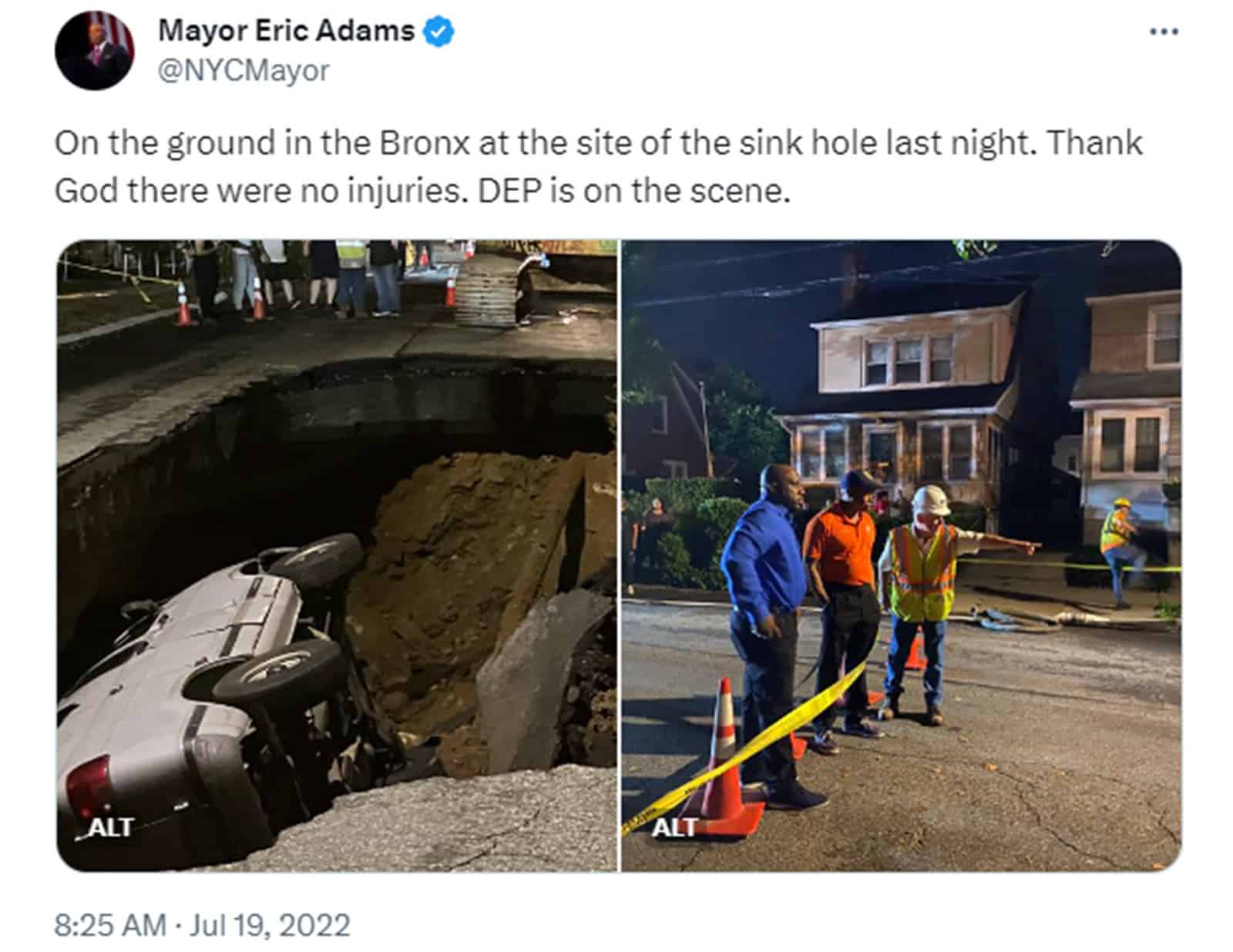
V. NYC’s Response to Sinkholes and Future Considerations
Recognizing the increasing threat of sinkholes in NYC, the leadership of New York City, and its associated agencies have taken several measures to address the issue of sinkholes in NYC and to improve public safety. These efforts include:
- Infrastructure Upgrades: NYC has committed to investing in upgrading and maintaining its aging infrastructure, including water and sewer systems. Upgrading NYC’s infrastructure is quite a complicated challenge. It must be multifaceted, well-planned, and well-funded. In terms of NYC sinkholes, besides infrastructure upgrades, regular inspections and proactive repairs are essential in reducing the risk of sinkholes.
- Improved Drainage Systems: The city is working to enhance drainage systems to manage excess rainwater more effectively and reduce the chances of soil erosion and sinkhole formation during heavy rainstorms.
- Monitoring and Research: Scientists and engineers are continuously monitoring geological conditions to better predict and understand sinkholes. Recent advances in technology and data analysis are available and are actively helping identify high-risk areas.
- Public Awareness: Public awareness campaigns and education about sinkholes and their potential risks are being promoted to ensure that residents are prepared and know what to do in case of a sinkhole incident. In many instances, this means being proactive before the calamity of a sinkhole occurs.
A Conclusion about Sinkholes In NYC
Sinkholes in NYC have become a growing concern due to various factors. Among these factors are an aging infrastructure, increased rainfall, lower groundwater tables, and urban development. While the city historically has not been a sinkhole hot-spot, recent trends suggest that their frequency is on the rise.
The dangers posed by sinkholes to buildings, pedestrians, bicyclists, and vehicular traffic are significant. Along with the potential dangers are potential economic consequences as well.
A comprehensive effort to repair a sinkhole involves immediate safety measures, thorough assessment, filling the void, repairing damaged infrastructure, and properly addressing the root cause as well. NYC’s response to the issue includes infrastructure upgrades, improved drainage systems, monitoring, research, and public awareness campaigns.
As sinkholes continue to emerge as a real threat to the city, ongoing vigilance, investment, and scientific research are necessary to protect the safety and well-being of New York City’s residents and visitors.
